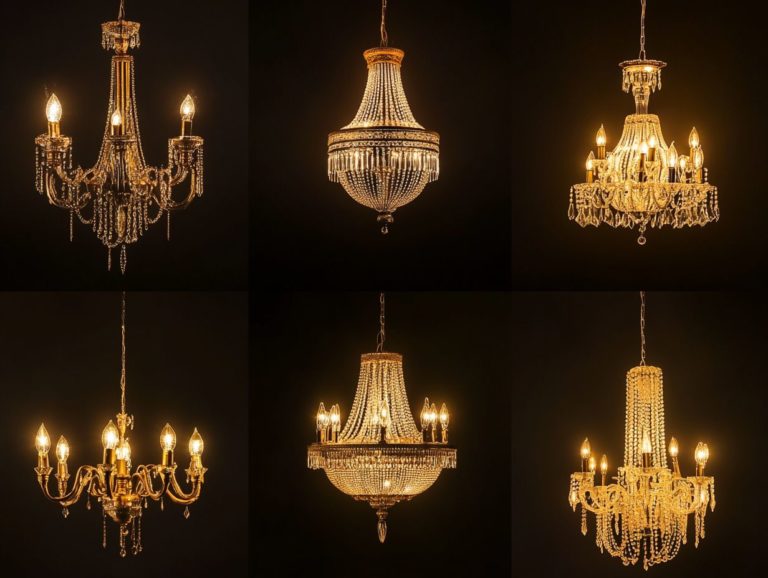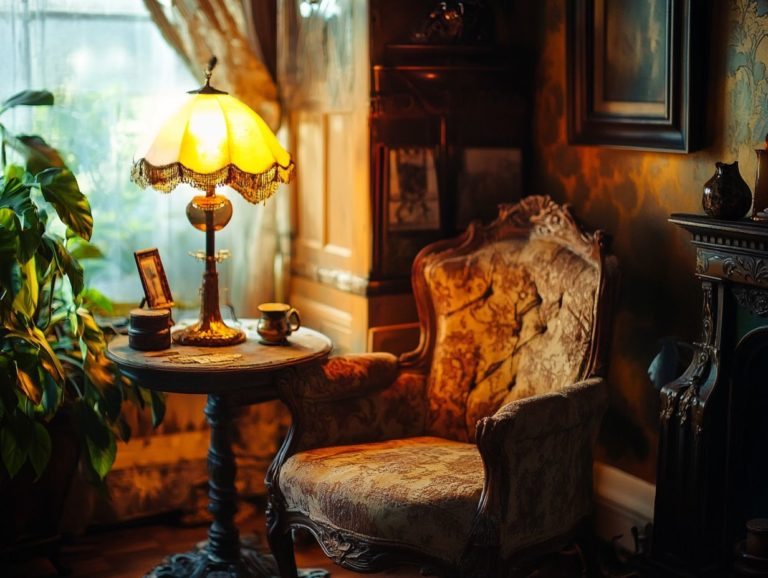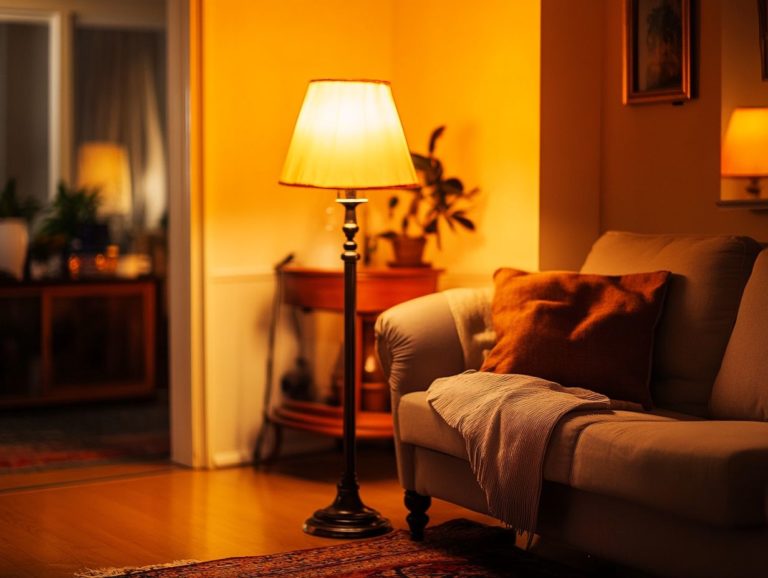Lighting Styles: From Art Deco to Mid-Century
Lighting is essential in shaping the ambiance of any space, merging functionality with artistic expression.
This article delves into a rich variety of lighting styles, spanning from the glamorous, geometric elegance of Art Deco to the refined simplicity of Mid-Century modernism. It showcases the rugged charm of industrial lighting, the understated appeal of Scandinavian design, and the latest innovations in modern illumination.
Whether you’re eager to refresh your home or deepen your appreciation for design history, get ready to explore a treasure trove of inspiration!
Contents
- Key Takeaways:
- Art Deco Lighting
- Mid-Century Lighting
- Industrial Lighting
- Scandinavian Lighting
- Minimalist Aesthetics and Functionality
- Modern Lighting
- Trends and Contemporary Designs
- Frequently Asked Questions
- What is the difference between Art Deco and Mid-Century lighting styles?
- Which lighting style is considered more luxurious, Art Deco or Mid-Century?
- Are there any famous examples of Art Deco and Mid-Century lighting styles?
- Can modern homes incorporate both Art Deco and Mid-Century lighting styles?
- What are some key features to look for when shopping for Art Deco or Mid-Century lighting?
- Can I mix and match Art Deco and Mid-Century lighting in the same room?
Key Takeaways:

- Art Deco lighting combines bold geometric shapes, luxurious materials, and intricate details to create a glamorous atmosphere.
- Mid-century lighting features clean lines, organic forms, and functionality, influenced by designers like George Nelson and Arne Jacobsen.
- Industrial lighting draws inspiration from factories, with exposed bulbs and metal elements adding a raw aesthetic to any space.
Overview of Different Styles
In the realm of interior design, various lighting styles bring distinct character and ambiance to spaces, each reflecting a unique historical context and aesthetic approach.
Whether it s the luxurious allure of Hollywood Regency or the minimalist charm of mid-century modern lighting, these styles lay the groundwork for creating inviting and visually captivating environments.
By incorporating elements like Bauhaus-inspired designs or Art Deco accents, you can achieve a harmonious balance of function and form, enhancing the design of each unique hotel room while embracing a refined yet dynamic look.
Choosing statement pendants can evoke a sense of drama and elegance, reminiscent of the opulence found in 1920s Art Deco interiors, where symmetry and bold geometric shapes reigned supreme.
On the other hand, sleek table lamps embody the essence of mid-century modern design, showcasing clean lines and innovative materials that reflect a shift toward simplicity and functionality.
By grasping the historical significance of each style, you can thoughtfully merge the old with the new, crafting spaces that not only meet contemporary demands but also celebrate the rich narratives woven throughout design history. This integration leads to environments that are both timeless and striking, inviting a diverse range of emotions and experiences.
Art Deco Lighting
Art Deco lighting is a distinguished design movement that blossomed in the 1920s and 1930s, defined by its striking geometric shapes, vivid fabrics, and intricate patterns.
This style beautifully blends elegance with practicality, presenting a range of general lighting, work lighting, and decorative lighting options that enhance the design of any space.
Characteristics and History
The Art Deco style embodies luxurious craftsmanship and bold shapes, reflecting a vibrant period of innovation and artistic exploration in the early 20th century.
This design movement emphasizes contrasting forms and geometric aesthetics while seamlessly integrating materials that evoke a sense of timeless elegance. It’s a perennial favorite, cherished in both historical and contemporary contexts.
Originating from the 1925 Exposition Internationale des Arts D coratifs et Industriels Modernes in Paris, Art Deco lighting stands as a hallmark of sophistication. It showcases intricate details and a unique blend of functionality with artistic flair.
Designers like Ren Lalique and Emile-Jacques Ruhlmann created iconic pieces that captured the spirit of their era, often featuring polished metals, rich glass, and vivid colors.
This design approach has not only influenced architecture and interior aesthetics but also continues to resonate in today s minimalist and eclectic styles, revealing the enduring impact of Art Deco on modern design sensibilities.
Mid-Century Lighting
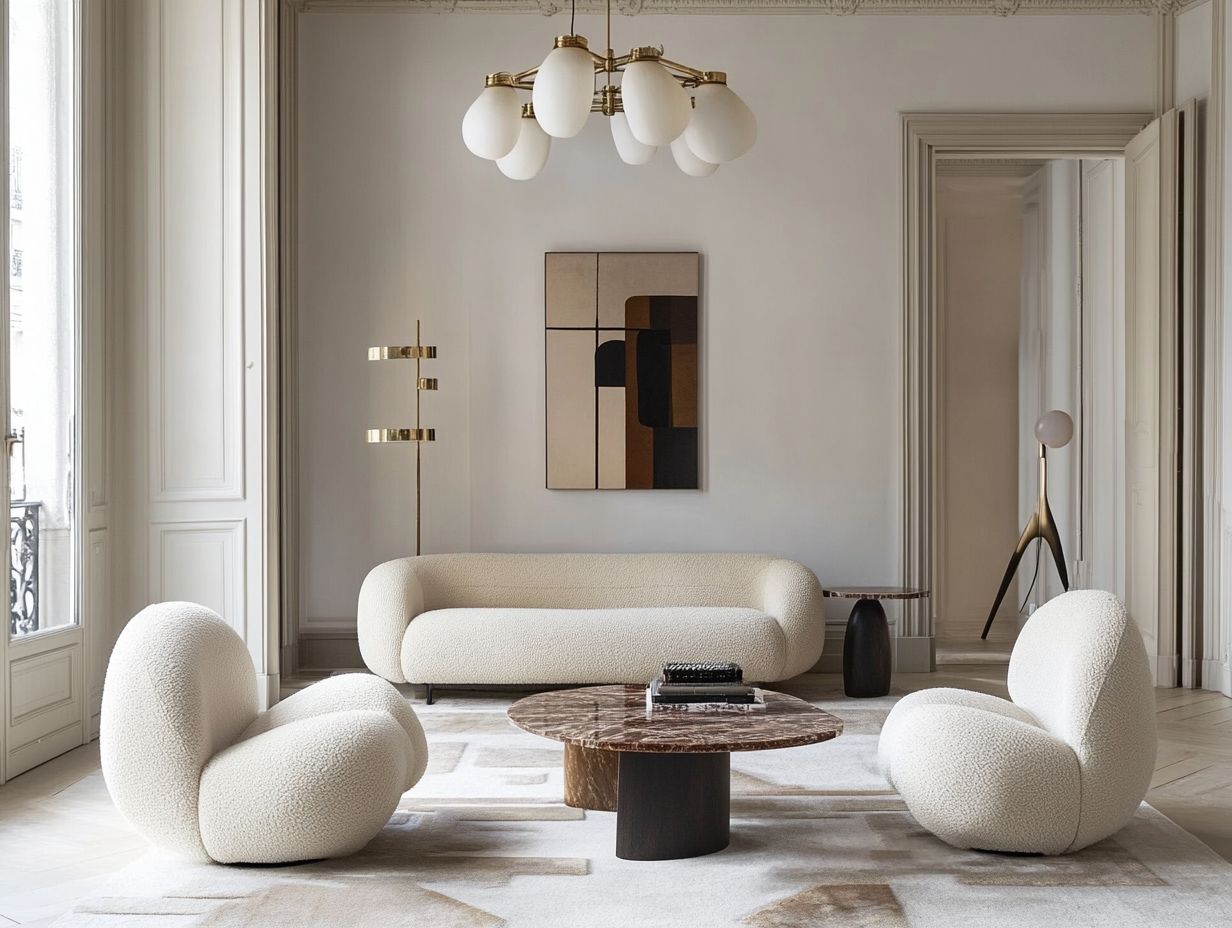
Mid-century lighting is a highly esteemed design aesthetic that thrived from the 1940s to the 1960s. This period bursts with a captivating aesthetic that you ll love!
Iconic pieces like the 101 Copenhagen Drop and El Cubo by Carpyen embody a harmonious blend of form and function.
Influential Designers and Features
Prominent figures like Gabriel Teixid and Olivier Desbordes have profoundly shaped mid-century modern lighting. Their distinctive vanities and elegant fixtures illustrate how mid-century modern style seamlessly marries form with utility.
Their works reflect the era s principles of simplicity, clean lines, and organic forms. Teixid s use of materials like metal and glass showcases a flawless integration of form and function.
Desbordes playful exploration of light and space captures the essence of mid-century innovation. These celebrated creators have set the stage for contemporary lighting choices.
Modern designers continue to draw inspiration from their signature styles, aiming to evoke that same timeless elegance and practical beauty in today s spaces.
Industrial Lighting
Industrial lighting embodies a design style deeply rooted in the utilitarian aesthetics of factories and warehouses. Originating in the late 19th century, it responds to urbanization and technological progress.
This style is distinguished by its use of natural materials and an emphasis on craftsmanship. It seamlessly blends innovative vision with a dynamic flair that enhances contemporary interiors.
Origins and Popular Applications
The origins of industrial lighting can be traced back to urban environments requiring practical solutions for illuminating expansive spaces. Functionality took center stage in this design style.
It beautifully combines elements of ambient lighting, which fills the room, and task lighting, intended for specific tasks like reading or cooking. This results in spaces that are visually captivating and exceptionally practical.
The historical evolution of industrial lighting reflects the journey of industry itself, moving from basic gas lamps to cutting-edge LED technologies. This approach captures a unique blend of rugged aesthetics and efficient performance.
More than just providing light, industrial lighting fixtures act as striking statement pieces. They elevate interior decor while ensuring optimal visibility for various tasks.
In commercial settings whether it s a bustling warehouse or a cozy caf this type of lighting streamlines workflows. It enhances customer experiences, underscoring its vital role in both residential and commercial design.
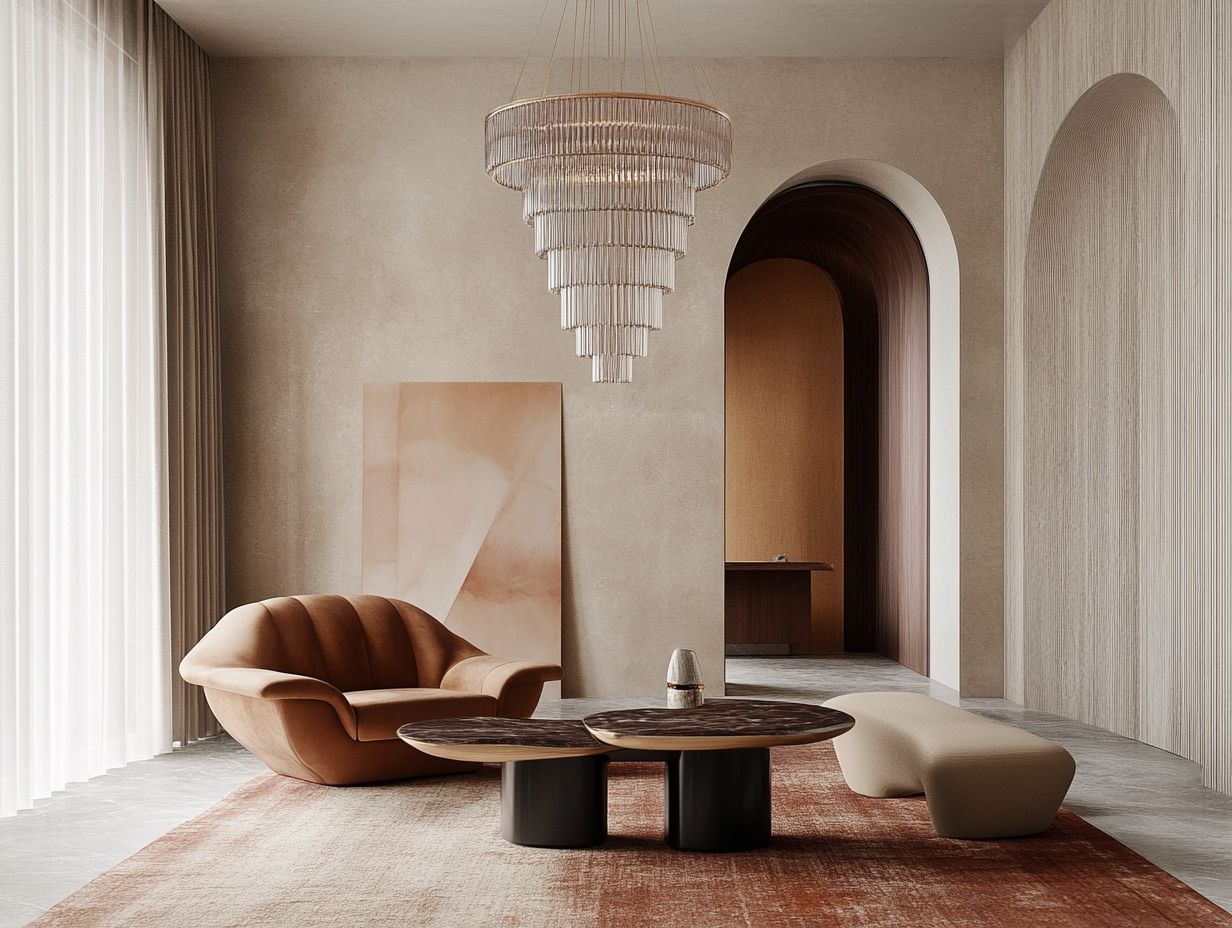
Scandinavian lighting is revered for its minimalist charm, featuring clean lines and natural materials. This design philosophy cultivates an inviting and tranquil ambiance.
Standout pieces like the Market Set Sonia and Globen Lighting exemplify this ethos. They enhance your spaces with effective ambient lighting, transforming any environment into a serene haven.
Minimalist Aesthetics and Functionality
The minimalist approach in Scandinavian lighting puts functionality at the forefront. It maintains an aesthetic appeal that enhances any space.
By focusing on ambient lighting, this style elevates the atmosphere while remaining elegantly understated and unobtrusive.
With clean lines and neutral color palettes, Scandinavian lighting fixtures seamlessly integrate into various interior styles. This creates a harmonious feel throughout your home.
For instance, pendant lights crafted from natural materials like wood or metal can serve as striking focal points above dining tables. They perfectly balance beauty with practical illumination.
Incorporating dimmable options lets you effortlessly adjust the mood for any occasion. Whether you re hosting a vibrant dinner party or savoring a cozy evening alone, this perfect blend of style and practicality enhances aesthetics.
It also cultivates a warm and inviting environment, making it a go-to choice for modern interiors.
Modern Lighting
Modern lighting embodies the pinnacle of contemporary trends and design, presenting a fusion of creative ideas and artistry in each piece. Whether it s a sleek table lamp or a sculptural floor lamp, this style embraces various mixed materials and advanced techniques.
It reflects a desire to push boundaries and redefine traditional concepts of illumination, inviting you to experience light in an entirely new way.
Trends and Contemporary Designs
Current trends in modern lighting showcase a captivating blend of bold shapes and exceptional craftsmanship. This results in pieces that function beautifully while making artistic statements within your spaces.
This design movement places significant emphasis on ambient lighting solutions that illuminate and elevate the aesthetic appeal of unique hotel rooms and contemporary interiors.
Take, for example, oversized statement pendant lights featuring geometric designs. They’re bound to catch the eye and often become the focal point in dining areas.
Sculptural floor lamps, on the other hand, can inject a dramatic flair into living rooms.
The surge in popularity of sustainable materials and innovative techniques, such as 3D printing, encourages designers to venture into unconventional forms and textures. Designs inspired by Bauhaus redefine the interaction between light and space.
This profoundly influences how you perceive your environment. The careful selection of lighting becomes an essential aspect of contemporary interior design.
Whether you lean towards a minimalist aesthetic or prefer a more eclectic approach with vibrant-colored fabrics, the right lighting transforms an ordinary setting into an extraordinary experience.
Frequently Asked Questions
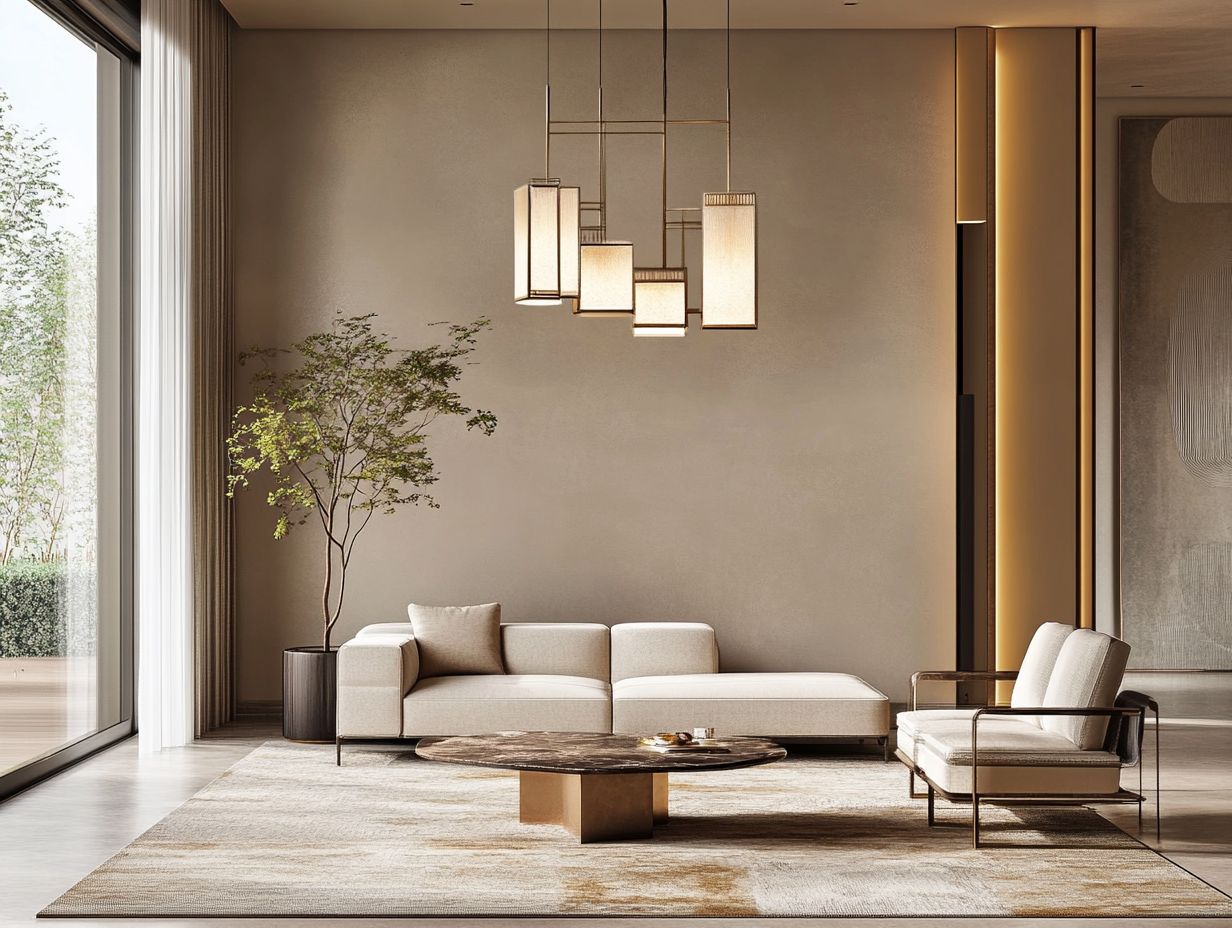
What is the difference between Art Deco and Mid-Century lighting styles?
Art Deco lighting features geometric shapes and luxurious materials like chrome and glass. Mid-Century lighting is known for its simplicity and organic shapes, often using natural materials like wood and brass.
Which lighting style is considered more luxurious, Art Deco or Mid-Century?
Both styles have elements of luxury, but Art Deco is typically seen as more opulent due to its glamorous materials and intricate designs.
Are there any famous examples of Art Deco and Mid-Century lighting styles?
Yes! The Chrysler Building in New York City is a famous example of Art Deco lighting, showcasing its iconic spiral lighting fixtures. The Sputnik chandelier is a well-known example of mid-century modern lighting, featuring its unique atomic-inspired design.
Can modern homes incorporate both Art Deco and Mid-Century lighting styles?
Absolutely! Many modern homes mix different lighting styles. Art Deco and Mid-Century can complement each other well; just be sure to balance the different elements for a cohesive look.
Explore these styles today and let your space shine!
What are some key features to look for when shopping for Art Deco or Mid-Century lighting?
When shopping for Art Deco lighting, look for angular shapes, bold colors, and shiny materials. Mid-Century lighting often showcases clean lines and organic shapes in warm, natural materials.
Pay attention to the size and scale of the lighting. This ensures it fits perfectly in your space.
Can I mix and match Art Deco and Mid-Century lighting in the same room?
Absolutely! Mixing Hollywood Regency and Mid-Century modern lighting creates a stunning, personalized atmosphere.
Create a sense of balance and harmony by choosing pieces that complement each other in shape, color, and size.

